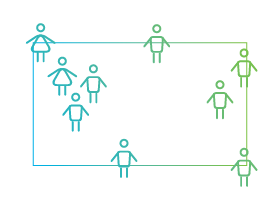The Full Circle Box: In search of greater board diversity
04 Feb 2020
The evidence is clear – diversity pays off in better decision-making. Indeed, one study showed that having diversity of Gender, Age and Geographic location results in better decisions being made 87%1 of the time. But despite the evidence that diverse boards make better decisions and manage risk more effectively, there is still a lack of diversity across pensions boards. Before we can explore what can be done to change this, we need to know what we're aiming for.
Ultimate goal
Perhaps an ideal scenario would be one in which the board of trustees represents a large cohort of members. As a starter, this representation might come from the following areas:
- Age - whilst experience is important, age diversity has been shown to improve decision making. Furthermore, increased numbers of younger trustees on DC boards in particular will ensure a larger proportion of the membership is represented. Younger trustees may also have different priorities to older trustees – for example, climate change is often considered more important to younger people.
- Gender – gender diversity is also important to ensure the membership is more fairly represented. Furthermore, gender diversity could lead to broader thinking when making decisions – and perhaps greater insight into issues such as narrowing the gender savings gap.
- Skills and Experience – a broader mix of skills and experience reduces the risk of trustee boards having significant gaps in their knowledge, as well as providing greater experience to draw upon when working to overcome challenges.
- Background – a male and female, of a similar age and background, may not result in diverse thinking. Therefore, having a board with a mixture of different backgrounds will again result in broader thinking and also in a larger proportion of members being represented.
Aristotle said the sum of the parts is greater than the whole. The pictures below show how a diverse team may think more broadly than a team who think similarly, where the people represent board members and the squares represent the knowledge you want to cover2.

How do we get there?
It is clear that diversity is important, but the question is how can it be achieved? Some options include:
- Review the recruitment and selection processes of trustees – a lack of engagement in pensions generally may result in a lack of interest in being a trustee. How to get members to engage in pensions is an area of constant development. Selling the trustee role as ‘board experience’ and getting the Human Resources team involved to sell the opportunity will often help.
- Consider the world beyond pensions – all organisations need to consider governance, and corporate governance standards in the UK are generally very good. Looking at how they approach diversity may help pension trustee boards. Some organisations use shadow boards, where younger people advise typically older executives. The shadow board helps create ideas, increase transparency and provide a different viewpoint.
- A quota style system could be considered and indeed is the practice in some European countries, with requirements on the age and gender mix of boards – such quotas may ensure diverse representation but may result in the loss of good trustees. There seems little point in appointing someone just to meet a quota – this would result in the following picture. Diversity is achieved, but at the expense of relevant knowledge and skills.

In their recent consultation on trusteeship and governance, TPR considered diversity and the possibility of mandatory reporting on efforts to enhance it. Their final response is expected imminently - it will be great if we as an industry can aim for the full circle box!
1 Forbes, Diversity + Inclusion = Better Decision Making At Work.
2 The three diagrams are from the book “Rebel Ideas” by Matthew Syed.




0 comments on this post